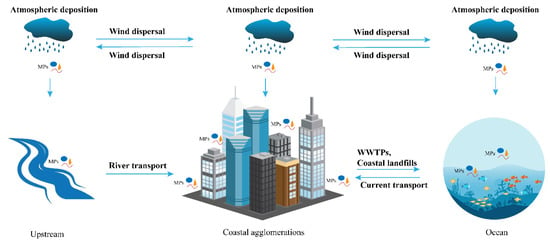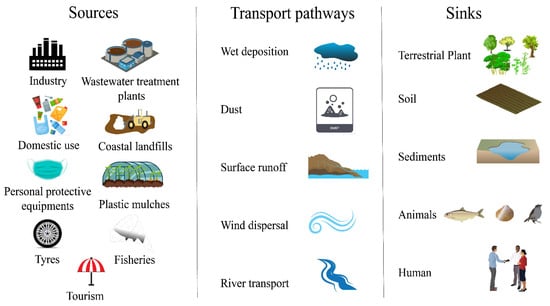Microplastics are ubiquitously in various environments from the equator to the poles. Coastal agglomerations act as both a source and sink connecting the global microplastic cycles of oceans and continents. While the problem of microplastics is particularly severe and complex in the coastal zones, where both inland and marine pollution are concentrated, the present research aimed to provide hot topics and trend of coastal urban microplastic studies and to review the researches on microplastic pollution in the atmosphere and water bodies in coastal agglomerations in terms of characteristics, behavior and health threat of microplastics. The results of the bibliometric analysis showed an increase in the annual output of microplastic research. Research hot topics and clusters were analyzed using the VOSviewer. Characteristics of microplastics varied in abundance, size and polymer type in different environments and countries. Furthermore, coastal cities are taken as a system to sort out the input, output, and internal transmission pathways of microplastics. The health threat of microplastics to urban residents was briefly reviewed and the exposure and health risks of microplastics to infants and young children were of particular concern. Detailed and comprehensive studies on intervention and reduction in the transmission of microplastics between the atmosphere and water bodies, whether microplastics are harmful to infants and young children, and measures to reduce the risk of microplastic exposure are needed.
Microplastics are ubiquitously in various environments from the equator to the poles. Coastal agglomerations act as both a source and sink connecting the global microplastic cycles of oceans and continents. While the problem of microplastics is particularly severe and complex in the coastal zones, where both inland and marine pollution are concentrated, the present study aimed to provide hot topics and trend of coastal urban microplastic studies and to review the researches on microplastic pollution in the atmosphere and water bodies in coastal agglomerations in terms of characteristics, behavior and health threat of microplastics. The results of the bibliometric analysis showed an increase in the annual output of microplastic research. Research hot topics and clusters were analyzed using the VOSviewer. Characteristics of microplastics varied in abundance, size and polymer type in different environments and countries. Furthermore, coastal cities are taken as a system to sort out the input, output, and internal transmission pathways of microplastics. The health threat of microplastics to urban residents was briefly reviewed and the exposure and health risks of microplastics to infants and young children were of particular concern. Detailed and comprehensive studies on intervention and reduction in the transmission of microplastics between the atmosphere and water bodies, whether microplastics are harmful to infants and young children, and measures to reduce the risk of microplastic exposure are needed.
- atmospheric microplastic
- freshwater
- seawater
- transport
- urban city
- health threat
1. Introduction
2. Characteristics of MPs in Coastal Agglomerations
Sampling and monitoring of urban freshwater systems, estuaries, surface and deep seawater, surface runoff, and influent and effluent of WWTPs have been reported more frequently around the world, and although data are still insufficient, this is a fundamental part of the background research on MPs in coastal agglomerations. MPs in different coastal urban waters vary in abundance and characteristics. Among them, MP pollution tends to be more severe in small freshwater bodies than in estuaries and coastal areas [20][25]. In addition, WWTPs have become a research hotspot as a point source [21][23] for MPs in urban water systems and coastal environments. The removal efficiency ranged from 70%–98%, while the size, shape, and type of MPs affected the removal and were related to SS concentration in the influent water and operational load [18][22][23][24][18,26,27,28]. To date, there have been far more studies of MPs in the aqueous environment than in the urban atmosphere. Among them, several reviews on MPs in urban and coastal waters have been described [25][26][27][29,30,31]; therefore, we will not repeat herein. Atmospheric microplastics sampling methods are broadly divided into active and passive sampling, the former is usually used to collect suspended aerosols using pump-powered total suspended particulate samplers, and the unit of microplastics is often expressed as particle/m3 or n/m3, while the latter usually uses non-plastic containers with funnels to collect atmospheric deposited particulate matter under the action of gravity, and the unit is often expressed as settling flux n/(m2·d). Occasionally, n/g is also used to indicate microplastic deposition, when the collected sample is usually dust or soil. After pre-treatments, such as sieving, ablation, density separation, and filtration, microscopy and electron microscopy are commonly used to observe and characterize the physical properties of microplastics (e.g., color, morphology, length, degree of wear, etc.), and further to determine the chemical characteristics of microplastics (polymer type, additive composition, etc.) using FTIR, Raman spectroscopy, SEM-DES, LC-MS/MS, etc. The levels of MPs in the urban atmospheric environment in the available studies showed that the units of measurement are not uniform in the presentation of study data. In terms of deposition fluxes, the highest deposition levels were found in Yantai, China (130–624 n/m2·d) while the lowest was in Jakarta (3–40 n/m2·d). Studies in China focused on coastal cities (Shanghai, Yantai, Dongguan), which is important for understanding the sea-land transport of atmospheric MPs. Fibers were the dominant form of MPs in the above cities (except for Wenzhou, China, and Hamburg, Germany, where most of the atmospheric MPs are fragments). Klein and Fischer [28][33] speculated that this difference was likely due to the different methods used in the study, including sample size, sampler height, and analysis methods. Some debris, films, and foam were detected in atmospheric deposition in Dongguan, Shanghai, Yantai, and Jakarta. Due to the difficulty of manually picking out microplastics and the limitations of the minimum detection limits of spectroscopy-type detection machines, such as FTIR, the minimum size of MPs varies from 2 to 200 μm, although there is a trend to lower the detection limit to 50 μm after 2019. However, the trend of the particle size distribution shows that the number of MPs increases with the decreasing particle size, thus the presence of a large number of small particle-size MPs in the air may be more hazardous to human health [14][29][30][14,34,45]. Polymer identification assists in analyzing the source of MPs. In most studies of atmospheric MPs, the chemical composition of MPs was identified. It can be concluded that polypropylene (PP), polyethylene (PE), polystyrene (PS), and polyethylene terephthalate (PET) were the main polymer components in atmospheric deposition. Some characteristic MPs can reflect the specificity of pollution at the sampling site, for example, PB (polybutadiene) was only present in atmospheric deposition in Jakarta compared to the atmosphere of other cities [31][35]. This assists in tracing the specific sources of MPs contamination, which can be controlled and eliminated at the source. Moreover, the backward trajectory is a common way to trace the sources of atmospheric MPs. Jia et al. [32][46] found that airborne MPs in Shanghai, a megacity, are dominated mainly by exogenous sources, and that precipitation and wind were the main influences on atmospheric MP deposition fluxes and characteristics at small scales, while at large scales, the fluxes were closely related to population size.3. Behaviors of MPs in Coastal Agglomerations
The behaviors of MPs in coastal agglomerations contain intricate material exchanges among the sea, the interior, and the participating cities. As a result, the urban agglomerations are considered a system (i.e., a coastal urban system) in this research, which allows for a simplified and clear discussion of their MP input and output as well as the specific types of MP sources, sinks, and transmission pathways within (Figure 1).
3.1. MP Input in the Coastal Urban System
The current research shows that the input of MPs in coastal agglomerations mainly includes atmospheric transport, upstream freshwater input, and marine current input. Since this respapearchr mainly reviews behaviors in the atmosphere and water bodies, the behaviors of soil MPs will not be elaborated. Marine MPs can be transported into coastal cities by atmospheric pathways. MPs in seawater will be aerosolized into the atmosphere due to the action of wind or ocean waves, thus entering the transmission system of the atmosphere, being input to coastal cities by the action of wind, and entering the urban system through the process of dry or wet deposition. A regional atmospheric transport model established by Long et al. calculated that the adjacent Atlantic and Indian Oceans inputted approximately 0.35 kt of MPs larger than 10 μm per year to the Asian continent [33][47]. Similarly, inland MPs could also be transported to coastal cities due to meteorological factors, such as monsoons [34][48]. The second input is the transmission through the river. MPs with a density lower than water in the upstream freshwater are easy to migrate in the river through water flow, while high-density MPs are easy to settle in the short-range migration and occur in the sediments of downstream urban rivers. Moreover, the migration of MPs is affected by hydrodynamic conditions, weather conditions, MP size, morphology, biofilm attachment, etc. [35][49]. Luo et al. monitored the abundance of MPs (1.8~2.4 items/L) in freshwater, such as urban streams (Shanghai), Suzhou River, Huangpu River, estuarine, and near-coastal water bodies (0.9 items/L), indicating that the pollution of MPs in urban rivers was more serious than in estuaries and near-coastal water bodies, and more than 80% of MPs in urban rivers were found to be fibers [20][25], which had the possibility of long-distance transmission from upstream. In addition, studies had demonstrated the impact of flood events on the transport of MPs, with river MP concentrations increasing 5–8 folds during floods, especially more significantly at downstream sites [36][50]. The input of ocean waves could not be neglected. Marine-derived MPs (such as fishing gear fibers and ship paint debris) and nearshore MPs (such as coastal textile industry outflows) are carried by wind and waves and can be deposited and stored in coastal zones. This deposition process was not only influenced by the physical properties of the MPs themselves (size, morphology, density) but was also largely controlled by storm surge events [37][51].3.2. MP Output in the Coastal Urban System
Coastal agglomerations may continue to pollute the ocean with MPs through atmospheric transport. The concentration of suspended MPs in the atmosphere in coastal areas is higher than the ocean, which makes the MPs in coastal cities migrate to the sea, especially textile fiber MPs, which are easily transported through the atmosphere. Liu et al. estimated that 1.21 t of suspended MPs entered the marine ecosystem of the western Pacific per year [38][52]. Furthermore, taking the size and morphology of MPs into consideration, Long et al. estimated that the Asian continent exports about 4.2 kt of MPs to the adjacent Atlantic and Indian Oceans per year through a model [33][47]. MPs in coastal cities may also import MP pollution inland through atmospheric transport. Several studies have found the appearance and deposition of atmospheric MPs in sparsely populated polar regions and the Tibet Plateau [16][39][16,53], confirming the existence of long-distance transmission of atmospheric MPs. The source of atmospheric MPs could be roughly estimated based on wind strength, wind direction, and particle size. Atmospheric MP monitoring in south-central Canada revealed that potential sources of MPs included Toronto (200 km away) [40][54]. In addition, coastal cities can export MPs to the ocean through urban WWTPs and coastal landfills. According to research surveys, a WWTP in northern France was estimated to discharge 227 million MPs particles per day, and high concentrations of MPs had been observed in water bodies near coastal landfills, indicating that they served as an important route for MPs to enter the marine coastal environment [22][26].3.3. MP Sources and Sinks in the Coastal Urban System
There are complex MP transport networks within coastal urban systems. Figure 2 is an overview of the source, sink, and intermediate transmission pathways. This summarization assists in controlling MP pollution at the source and the end, and hinders the transmission of MPs through controllable engineering and technical means, thereby reducing its ecological risk.
